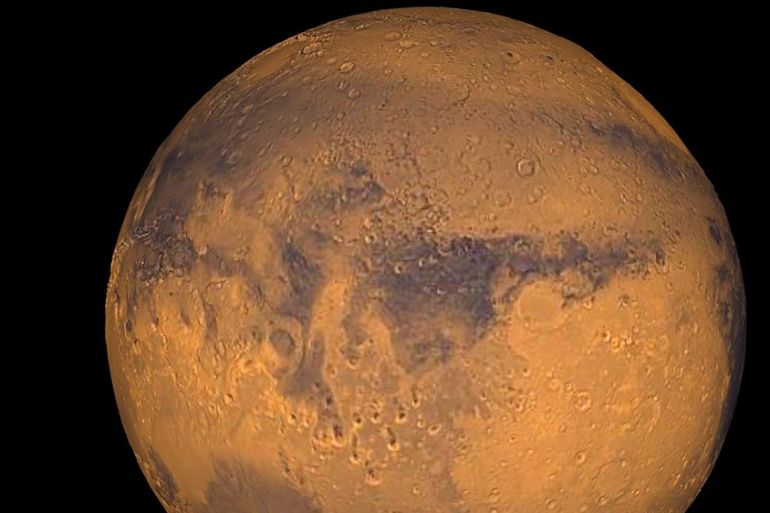NASA Mars mission: ‘Not willing to rule out 2033’
The US could get to Mars sooner than expected

NASA Administrator Jim Bridenstine told the United States Senate Committee on Commerce, Science, and Transportation that there is a path to reach Mars by 2033, contradicting an earlier independent report that found that timeline unfeasible.
“There are technologies that can be developed that accelerate the path and there are new approaches that I don’t think are being considered,” Bridenstine said. “I think if we could do that, I think we can accelerate the timeline. I have said publicly I am not willing to rule out the 2033 timeline.”
Keep reading
list of 4 itemsPhotos: Mexico, US, Canada mesmerised by rare total solar eclipse
Moment total solar eclipse occurs in North America
Millions across North America await total solar eclipse
The administrator made the comments while testifying before the Senate committee, which is charged with appropriating the funds to pay for both the NASA Artemis programme, which would return humans to the moon by 2024, and the endeavor to send humans to the surface of Mars within the following decade. The proposed $22.6bn NASA 2020 budget includes $12.3bn for the “Exploration Campaign”.
In its February report, the Science & Technology Policy Institute was deeply critical of the timeline established by the administration of President Donald Trump for reaching Mars. The institute stated that any further delays would realistically push the launch date back to 2039.
The report’s authors wrote, “We find that even without budget constraints, a Mars 2033 orbital mission cannot be realistically scheduled under NASA’s current and notional plans. Our analysis suggests that a Mars orbital mission could be carried out no earlier than the 2037 orbital window without accepting large technology development, schedule delay, cost overrun, and budget shortfall risks.”
Many advocates for a manned mission to Mars focus on the 2033 launch window because at that time, the planetary trajectories of the Earth and Mars will be such that the distance to the red planet will be at its shortest compared with other possible launch windows. A workable launch window to reach Mars only opens up once every 26 months.
The US space agency has come under increasing pressure to speed up timelines since Vice President Mike Pence announced in March that the administration wanted a return to the moon no later than 2024, four years less than the original target date. Additionally, the plan calls for touching down on the lunar South Pole, which has become a destination of extreme interest for China, India and Russia ever since water – in the form of ice – was discovered there in 2008.
While Bridenstine received praise from both sides of the aisle, the legislators expressed frustration with the current NASA budget ask. They did not dispute the dollar amount, but were more dismayed with the proposal’s lack of long-term planning, such as a five-year plan.
The administrator said filling key leadership positions would need to come first, and long-term planning with budgets second.
“Before we make commitments on timelines, I want to make sure that that new team is in place and that they have buy-in to realistic cost and schedule, so that ultimately it is their cost and schedule and they can be held accountable to it,” said Bridenstine, adding that this had been missing from past budgets and plans.
Last week, Bridenstine demoted two career staffers, Bill Gerstenmaier, the longtime head of NASA’s human spaceflight programmes, and Bill Hill, who had served under Gerstenmaier and shepherded the agency’s exploration systems development. Under their watch, the Boeing-built Space Launch System (SLS), a rocket more powerful than the Saturn V boosters that sent the first Apollo crews to the moon, had been plagued by cost overruns and repeated delays.
The SLS was supposed to take flight in 2017, but has remained earthbound and has already cost US taxpayers $13bn. Bridenstine said a longer-term “realistic” budget that included a year-by-year cost plan for the Artemis programme through 2024 would be delivered in the 2021 budget proposal early next year.
Bridenstine said he believes the SLS will get off the ground no later than 2021. At present, cost estimates for the overall human spaceflight programme, which includes missions to the moon and Mars, total $217.4bn.
The senators told Bridenstine that long-term planning needed to include mission vision, commercial leadership, appropriate spacesuits, and talent development to replace the aging workforces at both NASA and its commercial partners. Attracting young engineering and scientific talent, especially women, has been a challenge for both the agency and the private sector since the dawn of the space age.
Both Bridenstine and the senators agreed that the Artemis programme and the human mission to Mars require the same type of continuity of vision that underpinned the Apollo 11 mission. That mission was a continuous effort that spanned three presidential administrations governed by two political parties. John F. Kennedy delivered his famous “we choose to go to the moon” speech in September 1962. The Apollo 11 didn’t take off until 1969. By then, President Lyndon B. Johnson’s time in the White House had already come and gone, and Richard M. Nixon was enjoying his first few months in office.